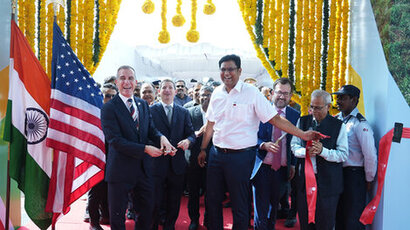
The inauguration ceremony was attended by the United States Ambassador to India, Eric Garcetti, and Scott Nathan, Chief Executive Officer of the US International Development Finance Corporation (DFC).
“We are pleased that First Solar chose Tamil Nadu for this landmark investment, solidifying our state’s position as India’s hub for manufacturing” said Dr T R B Rajaa. “This factory sets a high bar for sustainability and advanced manufacturing and has created high-value jobs as a result of its presence in our state, all while supporting India’s ambition to become self-sufficient in solar technology.”
The facility, which has an annual nameplate capacity of 3.3 gigawatts (GW) and directly employs approximately 1,000 people, produces First Solar’s Series 7 photovoltaic (PV) solar modules, which were developed at the company’s research and development centers in the US and optimised for the Indian market. First Solar is unique among the world’s largest solar manufacturers for being the only US-headquartered company. The company’s tellurium-based semiconductor, which allows it to avoid dependence on Chinese crystalline silicon supply chains, is the second most common photovoltaic technology available today.
“One month ago in Dubai, COP28 participants issued a bold call for the world to transition away from fossil fuels, to achieve net-zero emissions by 2050” added Ambassador Eric Garcetti. “This First Solar production facility will help advance our global transition to cleaner, greener energy, and stands as a shining example of what can be achieved when the United States and India work together – across government and private sectors – to achieve lasting climate action.”
Representing an investment of approximately $700 million, which includes $500 million in previously announced DFC financing, the facility is First Solar’s sixth operational factory and expands the company’s global manufacturing footprint to four countries, including the US, Malaysia, and Vietnam.
“The United States is leveraging American innovation and technology to diversify critical energy supply chains around the world and drive economic growth in India” said DFC CEO, Scott Nathan. “That’s good for the United States and it’s good for India. This $500 million in financing reflects the increasing strength of our partnership with India – DFC’s largest market and a like-minded partner with a dynamic private sector.”
Since the start of this decade, First Solar has embarked on a $4.1 billion manufacturing expansion strategy that has seen it grow from approximately 6 GW operational in 2020 to over 16 GW global nameplate capacity at the end of 2023. In addition to its India facility, the company also commissioned its third US factory, located in Ohio, in 2023. The company is further growing its footprint in the US with a 0.9 GW expansion of its Ohio manufacturing complex and new factories in the states of Alabama and Louisiana, which are each expected to add 3.5 GW of annual nameplate capacity, once commissioned and ramped. The company expects to have 25 GW of global annual nameplate capacity by 2026.
The factory, which is located in an area of high baseline water stress, is believed to be the world’s first net-zero water withdrawal solar manufacturing facility. Designed to minimise its impact on local water resources, the facility will rely entirely on tertiary treated reverse osmosis water from the city's sewage treatment plant and have zero wastewater discharge. Additionally, the factory is home to India’s first solar PV recycling plant. The company pioneered high value solar recycling, which provides closed-loop semiconductor recovery for use in new modules, while also recovering other materials including aluminum, glass, and laminates.
The Series 7 module produced by the new facility is the industry’s most eco-efficient with a carbon and water footprint that is approximately four times lower than crystalline silicon solar panels produced in China. The company’s sustainable manufacturing approach uses 50 percent less energy and only a third of the water than an equivalent polysilicon module production facility would require.
For additional information:

